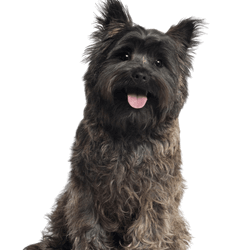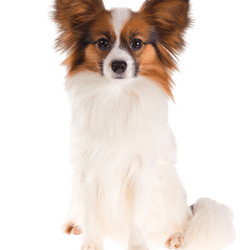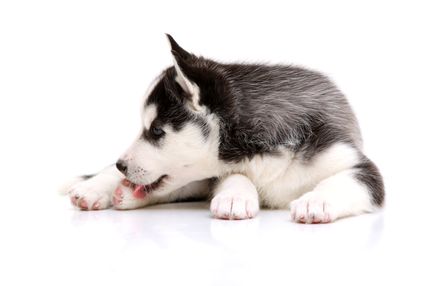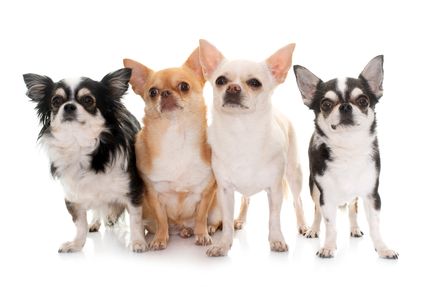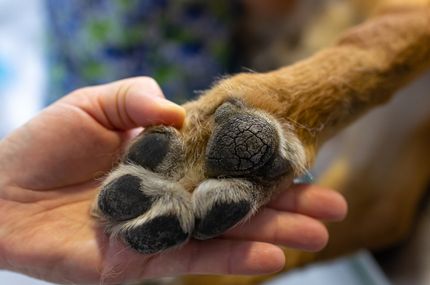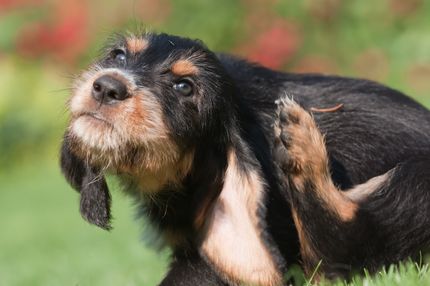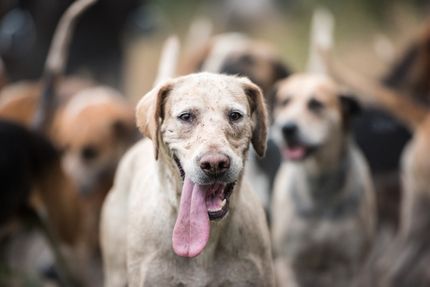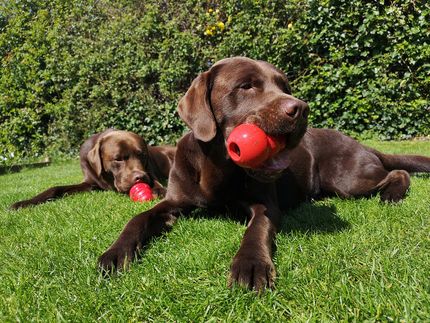Facts & Origin
Cairn Terrier and Papillon in one
The Carillon is a little-known but increasingly appreciated hybrid breed that is the result of crossing a Cairn Terrier with a Papillon. The aim of this combination was to unite the robust, lively nature of the Cairn Terrier with the playful, intelligent and charming nature of the Papillon.
Both parents are small, active breeds that are characterized by their intelligence, adaptability and people-oriented nature. Breeding of the Carillon - like many hybrid breeds - is likely to have started in the last two decades, particularly in the USA, as part of the trend towards designer dogs with deliberately selected characteristics.
Criticism of the Carillon
As with many hybrid breeds, there is also criticism of the Carillon, particularly from animal welfare groups and canine associations. As the Carillon is not recognized as an official breed, there are no uniform standards for appearance, temperament and health. This means that puppies within a litter can differ significantly from one another - both in terms of appearance and character.
Another point of criticism concerns breeding practices: without serious, health-checked parents, there is a risk that genetic weaknesses of both breeds will mix or intensify. The designer dog trend is also viewed critically if the focus is more on cute looks than responsible ownership.
There is also a risk with terrier mixes like the Carillon that their energetic, sometimes stubborn nature is underestimated - which can lead to problems in keeping them if there is not enough experience or commitment.
Suitability of the Carillon
Despite justified criticism, the Carillon can be a lively, clever and loyal companion dog if bred responsibly. It is particularly suitable for active people, couples or families with older children who enjoy spending time with their dog.
The Carillon is usually people-oriented, playful and very capable of learning. Due to the Papillon component, it often has a high level of trainability and sensitivity, while the Cairn Terrier provides energy, self-confidence and a thirst for adventure. This mixture makes him an entertaining and clever companion, but he needs clear boundaries and mental exercise.
He is ideal for people who like to play, exercise and go for walks - and want a small but active dog by their side. The Carillon is rather unsuitable as a pure lap dog, even if he appreciates affection and closeness. With the right guidance and activity, the Carillon will develop into a cheerful, loyal and very present companion.
| Alternate Name | Cairnpap, Papillon-Cairn-Mix |
| Origin | Scotland - France |
| Life expectancy | 12 - 15 years |
| Care requirements | low-maintenance |
| Activity level | average - average to high |
| FCI group | not recognised |
| AKC group | not recognised |
| KC group | not recognised |
More Cairn Terrier mixes
More Papillon mixes
Attitude, character and temperament of the breed
Possible character traits of the Carillon
The Carillon is generally a lively, intelligent and people-oriented dog with a lot of personality. The combination of Cairn Terrier and Papillon often produces a small dog that is both bold and adventurous as well as gentle and affectionate.
Typically, the Carillon is curious, playful and alert. He loves to learn and master new tasks - be it in trick training, nose work or retrieving games. His high level of intelligence makes him an excellent little training partner who quickly understands what is expected of him when given the right motivation.
At the same time, the Carillon can also be stubborn or independent - characteristics it inherits from the terrier. It therefore needs clear rules, loving consistency and variety in order to develop in a balanced way. If he is well socialized, he is usually friendly towards other dogs and people, although he can also have a certain vigilance and territorial attitude.
Overall, the Carillon is an active, intelligent small dog that appreciates mental activity as well as closeness to its caregivers.
Usage
Possible diseases of the Carillon
Even though mixed breeds such as the Carillon are often considered robust, hereditary diseases can still occur in both parents. Responsible breeding with health-tested parent dogs is therefore essential.
Possible diseases in the Carillon:
Patellar luxation (dislocation of the kneecap), common in small dog breeds
Dental problems, such as tartar and misalignment due to narrow jaws
Eye diseases, e.g. cataracts or progressive retinal atrophy
Heart problems, as can occur in the Papillon (e.g. mitral valve disease)
Allergies or skin sensitivities, partly diet-related
Liver or kidney problems, with a corresponding genetic burden
Many of these problems can be avoided or treated at an early stage with regular veterinary check-ups, an appropriate diet, good dental care and sufficient exercise.
This is what a Carillon can look like
As the Carillon is not a standardized breed, its appearance can vary, but it is small and compact in size. The shoulder height is usually between 20 and 28 centimetres, the weight is around 4 to 7 kilograms.
The build is often robust and elegant at the same time, with a straight back and well-developed muscles. The ears are a striking feature: depending on the genetic predisposition, they can be erect, semi-erect or drooping with fringes - especially in the case of a higher proportion of Papillon.
The coat is medium to long, often soft and slightly wavy, with a dense undercoat. It should be brushed regularly to avoid matting, but is generally easy to care for. Coat colors range from cream, white, grey, sand, brown to piebald or tricolor patterns.
The eyes are usually round, dark and expressive, the gaze attentive and friendly. Overall, the Carillon looks like a lively, elegant and alert small dog with a lot of charisma, both visually and in terms of character.
| Fur length | short - long |
| Fur | rough-haired - flat coated |
| Ear shape | Standing Ears |
| Tail | short - rolled up |
| Anatomy | strong, hefty, slim |
| Size ♀ | 20 - 30 cm |
| Weight ♀ | 2 - 8 kg |
| Size ♂ | 20 - 33 cm |
| Weight ♂ | 2 - 8 kg |
| Suitable For | - |
Known Diseases
Joint problems
Especially due to overweight, joint problems can occur in dogs.
Tartar
If dogs don't get a good food or sugary food, tartar can quickly appear.
Patellar luxation
Patellar luxation is the term used to describe a displacement of the kneecap, which is one of the most common causes of lameness in dogs.
FAQ
-
A Cairn Terrier-Papillon mix is a cross between two popular purebred dogs, the Cairn Terrier and the Papillon. These two breeds are both known for their independence, intelligence and alertness, so it is not surprising that their offspring inherit these traits as well. As a result, the Cairn Terrier-Papillon mix is an active and playful dog that does best in a home with plenty of room to run and play.
-
The Cairn Terrier and Papillon mix is a small to medium sized dog, usually weighing between 3 and 5 kg. They are usually between 20 and 25 cm tall.
-
A daily walk or play session is important to keep Carillons happy and healthy. They also need plenty of mental stimulation, so puzzles, chew toys and interactive games are a great way to keep their minds active.
-
The Cairn Terrier-Papillon mix is generally a healthy breed, but like all dogs, they are prone to certain health conditions. Some of the most common health problems in this breed are patellar luxation, hip dysplasia and deafness.
-
The Cairn Terrier-Papillon mix is a good choice for families with children. They are generally good-natured and patient with children, and due to their small size, they are less likely to accidentally knock a child over.
